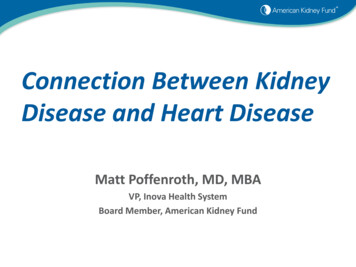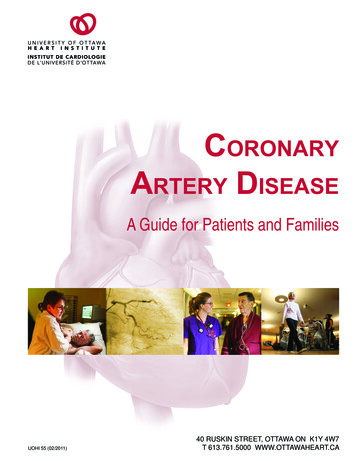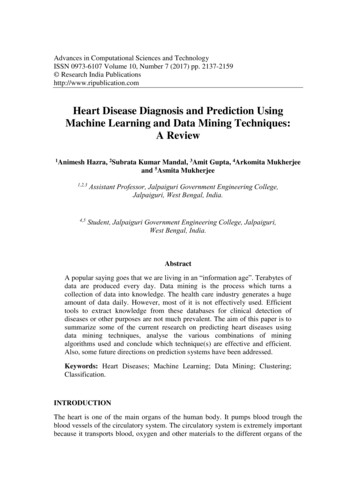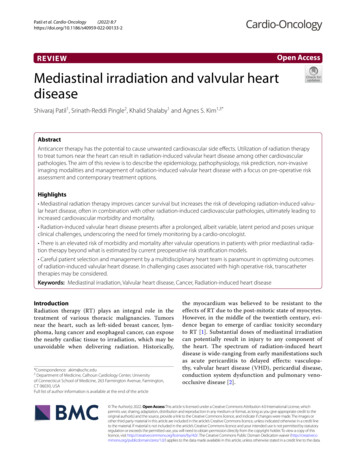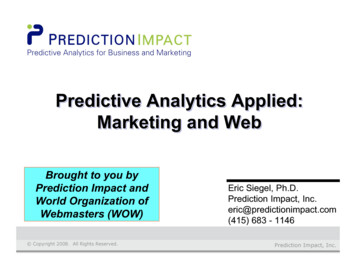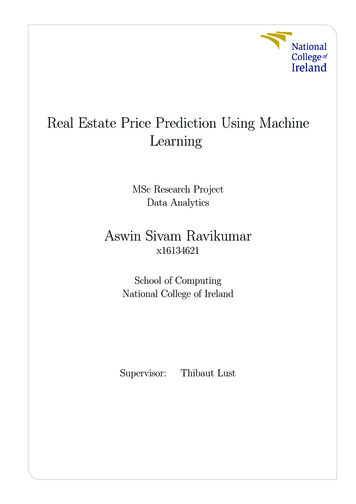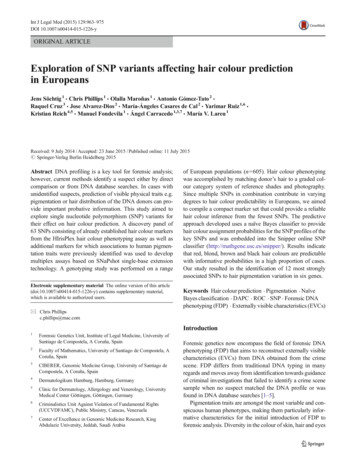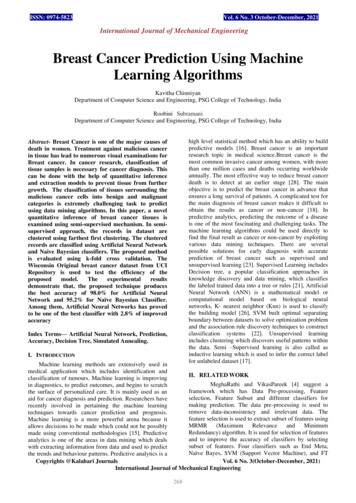
Transcription
International Journal on Electrical Engineering and Informatics - Volume 13, Number 3, September 2021Review on Effective Disease Prediction through Data Mining TechniquesMuhammad Nabeel1, Shumaila Majeed 2, Mazhar Javed Awan1*, Hooria Muslih-ud-Din3,Mashal Wasique 2 and Rabia Nasir 41Departmentof Software Engineering, University of Management and Technology, Lahore, PakistanDepartment of Computer Science, Fatima Jinnah Women University, Rawalpindi, Pakistan.3Department of Computer Science, National University of Computer and Emerging Sciences,Lahore, Pakistan.4Department of Anesthesia, Lahore General Hospital, Lahore, Pakistan.Corresponding author: *mazhar.awan@umt.edu.pk2Abstract: Hidden and unknown pattern are extracted from large data sets by performing severalcombinations of techniques from database and machine learning. Data mining plays a significantrole for handling a huge amount of data. Data mining deals with heterogeneity, privacy andcorrectness of data. Moreover, medical data mining is tremendously important research area andsignificant attempts are made in this area in recent years because inaccuracy in medical datasystems may cause seriously disingenuous medical treatments. Medical data sets should beanalyzed using suitable mining algorithms. To perform related operations, techniques of datamining have been used in developing medical systems for prediction of diseases through a set ofmedical data set. This paper reviews state of the art data mining algorithms for predictingdifferent diseases and to analyze the performance of classification techniques i.e. Naive Bayes(NB), J48, REF Tree, Sequential Minimal Optimization (SMO), Multi-Layer Perceptron andVote on different data sets of different diseases i.e. chronic kidney disease (CKD), heart disease,liver and diabetes. The experimental setup for performance evaluation of various algorithmsusing disease data sets retrieved from UCI respiratory has been made in WEKA tool. Values ofdifferent parameters i.e. correctly classified instances, precision, recall and F-Measure, timetaken are analyzed by applying different classification algorithms.Keywords: Naive Bayes, J48; REFTree, Sequential Minimal Optimization (SMO), multi-layerperceptron, vote, classification, prediction1. IntroductionData mining is the technique of knowledge discovery in which the knowledge is gathered byexamining the data which might be hidden in extremely large sources, these sources are analyzedfrom several perspectives using different techniques and then the extracted information issummarized into useful information. It is a process in which information from past records areextracted for making important decisions for future predictions. Data mining techniques arebecoming an important area of research for effective analysis of large data as the complexity andsize of the data increases [1]. Data mining is used in many domains i.e. image mining, opinionmining, web mining, text mining, graph mining, medical data systems. It has become animportant medical research area for finding unknown patterns in medical data. Medicalprofessionals can examine the diseases on prediction analysis given by prediction model. Inmedical field data mining technique plays a vital role to predict different diseases. In many casesdoctors may not be able to predict whether patient is suffering from one or more diseases at thesame time. With the advent of new developments in the field of medication, a lot of data aboutdifferent diseases have been gathered and are accessible to the research community [2]. Manychallenges and opportunities are faced, according to the data mining perspective, mining big datahas opened many new challenges and opportunities. A small number of data mining applicationshave been effectively provoked in different areas like extortion identification, retail, astronomy,social insurance, social media, money, banking, media transmission, climate modeling, medical,telecommunication, and hazard analysis etc. are not many to name [3]. In healthcare huge amountof data is being generated so, processing and analysis is required for knowledge extraction fromReceived: December 28th, 2020. Accepted: September 30th, 2021DOI: 10.15676/ijeei.2021.13.3.13717
Muhammad Nabeel, et al.such huge data. Mining algorithms predict the disease of patients using suitable learning strategy.Diseases like chronic kidney disease (CKD), hepatitis, cancer disease and diabetes have becomea worldwide health issue and therefore prediction of such type of diseases is the concerned areafor researchers. Our work mainly focuses on analyzing classification algorithms like NaiveBayes (NB) and Artificial Neural Network (ANN), J48, REF Tree for different life threateningdiseases like CKD. Mining techniques used in health care are described in fig1. There are twomain categories of data mining known as supervised and unsupervised [4]. Both approaches havedifferent applications and efficiency for analyzing and predicting the diseases. These techniquesmentioned above are used in medical field accordingly to predict diseases and for makingdecision for treatment of patients. Classification is a supervised technique in which objects areassigned in a collection to target classes. Decision tree, ANN, SVM, NB, etc are approaches ofclassification. Different approaches are used for different purposes in healthcare. In clusteringsimilar types of objects are categorized in the same group. K-means, K- medoids, agglomerative,divisive, DBSCAN etc are some of the techniques of clustering. Association is the possibility ofoccurrence of objects in a set. Further classification of Apriori is association. Hierarchy of datamining is shown in figure 1.Figure 1. The Taxonomy of Data MiningSo far, review of many mining techniques are done for different diseases separately butcomparative analysis of all these algorithms on different diseases was not done by any otherstudy. This study presents comparative survey of different algorithms on four different diseasesas well as the algorithms are implemented in Weka and discussed in terms of parameters i.e.correctly classified instances, precision, recall and F-Measure, time taken. Further organizationof paper in different sections are given as, section II gives a systematic review of algorithms usedfor predicting different diseases. Section III contains the simulation results and discussion.1. Literature ReviewData mining in healthcare is one of the most challenging field of application for knowledgediscovery. Medical data mining is challenging because of complexity, diversity and huge amountof data set. As the provided data set in health care are heterogeneous in nature, so predictingdisease of such heterogeneous and fragmented data is a challenging task [5]. This sectionprovides a comprehensive literature review of various algorithms of data mining used forpredicting different diseases. The performance analysis of various algorithms for prediction ofdifferent diseases given in literature are shown in table 1, table2, table 3 and table 4 respectively.718
Review on Effective Disease Prediction through Data Mining TechniquesA. Heart DiseasesNaive Bayes algorithm is used by [13] for predicting heart disease accurately. NeuralNetwork (NN), Decision Tree (DT) and NB are compared in the study and Naive Bayes performsthe best. Algorithms such as C5.0, SVM, KNN, NN and Logistic Regression are discussed by[25]. C5.0 Decision tree has the highest accuracy of 93.02% and thus improved the predictionsystem. Issues in predicting the heart disease are presented by [8] and algorithms such as KStar,J48, SMO, NaiveBayes and Multilayer Perceptron are investigated and implemented using toolWeka SMO shows the highest accuracy of 84.074%. KNN, Neural Network, Decision TreeAlgorithm, Naive Bayes are various classification techniques analyzed by [26] and it isconcluded that KNN and ID3 gives the maximum accuracy of 80.6% in heart disease riskprediction [27]. The comprehensive review of prediction algorithms for heart disease aredescribed in table1.Table 1. Comprehensive review of Mining Techniques for Heart 29][5]ModelsNaive Bayes, Neural Network and DecisionTree.C5.0, Neural Network,SVM, KNN andLogistic Regression,Custer, J48, SMO, Bayes Net, Multi-layerPerceptronNB, ID3, KNN, Decision Tree, NeuralNetwork.NB, Discriminant, Decision Tree, RandomForest, and SVMNaive Bayes, Random ForestApriori , SVM, Fuzzy rule based, NeuralNetwork, Regression Trees, Fuzzy Clinicaldecision support system, KNN, geneticalgorithm, type-2 Fuzzy Logic, DecisionTreeSVM combined with genetic algorithm,C5.0, Na ıve Bayesian, J4.8, KNN, NeuralNetwork, decision tree and FuzzyNB , KNN, Decision Tree, LogisticRegressionSVM, KNN, ANNNB, Decision Trees i.e. C5.0 boosted,CART, C4.5, and C5.0. random forestalgorithmsNaive Bayes, KNN, Decision Tree, SVM,Logistic Regression, Neural Network andVote (a hybrid technique with NB and LR).Highest Accuracy ModelNaive BayesAccuracy99%C5.0 Decision tree93.0%SMO84.07%KNN and ID380.6Decision tree and RandomForest99.0%Naive Bayes84.15%,84.16%SVMN/ASVMN/ALogistic RegressionN/ASVM85%CART87%Vote87.4%The Random Forest, NB, Decision Tree, Discriminant and SVM for predicting the heartdisease risk using two data set in MATLAB and concluded that Decision Tree, Random Forestgives the accuracy of 99.0 are best among all discussed algorithms [7].The purposes a hybridalgorithm of Random Forest and Naive Bayes and [7] concluded that the hybrid approachimproves the prediction of heart Disease. Naïve Bayes obtain accuracy of 84.1584%, whileRandom Forest attained 84.1604%. [28] Algorithms of data mining i.e. Apriori algorithm,Support Vector Machine, Neural Network, Classification and Regression Trees, Fuzzy rulebased clinical decision support system, K-nearest neighbor, Genetic algorithm, Type-2 fuzzy719
Muhammad Nabeel, et al.logic system, Decision Tree are discussed and it is concluded that SVM algorithm achieved bestaccuracy. Several analytic techniques i.e. SVM classifier with Genetic algorithm, NaiveBayesian, C5.0, Neural Network, KNN, J48, Decision tree and Fuzzy on FHS (FraminghamHeart Study) are analyzed by [14] and concluded that SVM classifier with genetic algorithmoutperforms. Naive Bayes, Decision Tree, KNN are analyzed by [9] for heart disease prediction.[6] Discussed classification techniques such as KNN, SVM and ANN for heart diseaseprediction. Data sets used for simulation are C-level and standard data set obtained from UCImachine learning repository. Results of the study shows that SVM perform better than that ofother algorithms with accuracy of 85.1852%. The experiments are done using MATLAB.[29]Analyzed algorithms Naive Bayes classifier, decision trees (C4.5, CART, C5.0 boosted, andC5.0) and Random Forest for prediction of acute rheumatic fever on cardiac disease andconclusion of the study shows that CART outperforms by 87%. [5]Studied the significantfeatures of algorithms such as KNN, Decision Tree, SVM, NB, Neural Network and LogisticRegression, Vote. Study concluded that Vote gives the best performance and achieved the 87.4%accuracy.B. Diabetes DiseasesANN, K-fold cross validation, Vector support machine, KNN method algorithms arediscussed and analyzed by [17] and study concluded that SVM outperforms with an accuracy of81.77% to predict diabetes. Algorithms i.e. Naive Bayes Classifier, C4.5, SVM, KNN isreviewed by [16] using PIMA Indian diabetes data sets and concluded that C4.5 algorithm ismore accurate than KNN with an accuracy of 78.25%. Bagging ensemble and Adaboosttechniques along with J48, c4.5, decision tree using Canadian Primary Care database andAdaboost have more accuracy [30]. Data mining algorithms such as Random Forest, SOM alsoC4.5 are experimented on data set of Ministry of National Guard Health Affairs (MNGHA) onadult population by [31]. Result shows that Random Forest achieve highest accuracy of 90%.KNN, Naive Bayes, Decision Tree are implemented by [32] on PID data set to predict Diabetesmellitus. Analysis results shows that Decision Tree has attained best accuracy 75.65% ascompared to other discussed algorithms. Simple CART and NB, J48 are compared by [33] andit is concluded that J48 and Simple CART are cost efficient and gives 99% result. SVM is betteraccording to [14] for diabetes as compared to Bayesian Classifier, SVM, Neural Network andDecision Tree algorithm. Genetic algorithm, H-means plus clustering and EM algorithm,Random Forest Classifier are analyzed by [34] and results concluded that Random Forest resultsare best in terms of accuracy. Algorithms such as Bayesian, SVM, and Decision Tree arecompared by [35] and a new hybrid technique is also proposed which attained 94% accuracy.Comprehensive review of techniques for Diabetes prediction are given in table 2.C. Liver DiseasesFuzzy based classification for Liver disorder prediction is applied by [23] and the purposedalgorithm gives the accuracy of 94%. Liver diseases are predicted using classification algorithmsNaive Bayes and SVM. Results shows that SVM performs better in predicting liver disease.Experiment is done using Matlab [21]. Decision Tree, NB, C4.5, SVM, Regression Tree andBack Propagation are some algorithms analyzed by [24] and results show that C4.5 performsbetter as compared to other algorithms. Performance of different algorithms like C5.0 andCHAID are compared in [36] using UCI repository data set.720
Review on Effective Disease Prediction through Data Mining TechniquesTable 2. Comprehensive review of Mining Techniques for Diabetes odelsK fold cross validation,CKNN, classification methods, SVM, LDASVM ,Feed ForwardNeural Network, Back propagation, ANN,Statistical Normalization.Naive Bayes, SVM, C4.5, KNN.Bagging ensemble , adaboost using J48 andC4.5.Self-organizing Map (SOM), C4.5 and RandomForest,Decision Tree, NB, KNN,J48, CART and Naive bayesBayesian Classifier, Neural Network, DecisionTree and SVM algorithm.EM algorithm, Genetic Algorithm, H-means clustering and Random Forest ClassifierBayesian, SVM, Decision Tree,Highest Accuracy ModelAccuracySVM81.77%C4.5Adaboost ensemblemethodRandom Forest78.25%Decision TreeJ48 and CART is costefficientSVM75.65%99 %Random ForestN/AHybrid proposed methodof decision tree and SVM94%N/A90%N/ABy doing performance evaluation it is concluded that C5.0 algorithm using Boosting techniqueachieved 93.75% accuracy in predicting liver diseases.Table 3. Comprehensive review of Mining Techniques for Liver 48][49]ModelsANN, SVMJ48, NB, SVM, Multilayer Perceptron,Decision Tree, Conjunctive Rule.Naive Bayes and SVM.Decision Tree (C4.5), SVM and BayesianNetworkDecision Tree, Naive Bayes, KNN, Rule based, Back Propagation , SVMBack Propagation Neural Network, One Ruleclassifier, NB, Decision Table, Decision treesand KNNSVM, Decision Tree,NB and Linear Regression, Neural Network.SVM,J48, Na ıve BayesK-Star, SVM, NB and J48multilayer perceptron, naive bayes and J48decision treeNaive Bayes, SVM, ANN and ANFISHighest AccuracyModelANNMultilayer ayer Perceptron,SVM,Radial Basis FunctionNaive Bayes,Random forest.N/ANaive Bayes99.36 %Neural NetworkN/ASVM gaveJ4875.75%99%J4887.3Naive Bayes and KNNN/ABoosted C5.0 combined with Genetic Algorithm (GA) is proposed by [37] and concludedthat accuracy is improved from 81 to 93%. Using WEKA [38] experimented Grading learningalgorithms, logitboost, Bagging, Adaboost are applied to this data set and concluded that Gradingalgorithm have shown highest accuracy of 71.3551%. [39] Analyzed Naive Bayes (NB), C5.0,721
Muhammad Nabeel, et al.K-means, KNN, Random Forest, C5.0 with Adaptive Boosting and concluded that C5.0 withAdaptive Boosting performs better. K-Nearest Neighbour outperforms among other algorithmsdiscussed in the study such as Auto Neural, Random Forest and Logistic regression. Conclusionof the study have shown that KNN have highest accuracy of 99.794% [40]. Boosting C5.0 hasthe highest accuracy as compared to SVM, Exhaustive CHAID and CHAID according to [41].Random forest (RF), ANN, NB and Logistic Regression are discussed in the study according tostudy Random Forest outperforms and attained accuracy of 87.48%. Comprehensive Review ofliver Disease prediction algorithms is given in table 3.D. Kidney DiseasesANN and SVM are compared by [18] and concluded that ANN achieved better accuracywhile SVM achieved better execution time. ANN shows 87.70% accuracy. [20]Multi-layerperceptron algorithm performs best among Naive Bayes, Decision Tree, SVM, MultilayerPerceptron, J48, conjunctive rule. Multi-layer perceptron attained 99.75% accuracy. The SVMand NB are compared by [44] and concluded that SVM outperform by achieving 76.32%accuracy. The SVM, C4.5, Decision Tree and Bayesian Network are Compared and discussed in[19].Table 4. Comprehensive review of Mining Techniques for Kidney DiseasesPaperModelsHighest Accuracy ModelAccuracy[18][20]ANN, SVMJ48, NB, SVM, Multilayer Perceptron,Decision Tree, Conjunctive Rule.Naive Bayes and SVM.Decision Tree (C4.5), SVM and BayesianNetworkANNMultilayer Perceptron87.7099.75%SVMC4.576.32N/AMultilayer Perceptron,SVM,Radial Basis FunctionNaive Bayes,Random forest.N/ANaive Bayes99.36 %Neural NetworkN/ASVM gaveJ4875.75%99%J4887.3Naive Bayes and KNNN/A[43][19][22][44][45][46][47][48][49]Decision Tree, Naive Bayes, KNN, Rulebased, Back Propagation , SVMBack Propagation Neural Network, OneRule classifier, NB, Decision Table,Decision trees and KNNSVM, Decision Tree,NB and Linear Regression, NeuralNetwork.SVM,J48, Naive BayesK-Star, SVM, NB and J48multilayer perceptron, naive bayes andJ48 decision treeNaive Bayes, SVM, ANN and ANFISAccording to [19] C4.5 achieved better accuracy and execution time. Hidden patternRelationship of CKD is discovered by [22] using classification techniques i.e. KNN, DecisionTree, ANN. For prediction of chronic kidney it is analyzed that Random Forest, SVM, NB,Multilayer Perceptron, Radial Basis and KNN Function enhance the accuracy. Algorithms suchas Decision Table, NB, Decision trees, Back Propagation Neural Network, KNN and One RuleClassifier are compared by [45] for chronic kidney disease prediction and concluded that NaiveBayes gives best accuracy 99.36 %. Decision Tree, Linear Regressing, SVM, Neural Networkand Naive Bayesian are experimented using UCI data base. Neural Network performs best for722
Review on Effective Disease Prediction through Data Mining Techniqueschronic kidney disease prediction according to review by [46]. Techniques i.e. Artificial NeuralNetwork, Decision Tree and KNN are implemented by [47] to discover hidden patterns of CKD,SVM, J48, and Naive Bayes SVM gave maximum accuracy of 75.75%. [48] K-Star, NB, SVMand J48 classifiers are some algorithms discussed in the study. Outcome of the study shows thatJ48 outperforms with 99%. [49-56] Implemented Multi-layer perceptron, NB and J48 decisiontree was using WEKA in this study. J48 decision tree performs best 87.3%. Techniques likeNaive Bayes, SVM, ANN and ANFIS Naive Bayes and KNN are compared by [57-62]. Thestudy concluded that Naive Bayes and KNN performs best. Comprehensive review of algorithmsfor kidney prediction is shown in table 4.2. Result ComparisonHeart can be affected by a different condition which includes blood vessel disease known ascoronary artery disease (CAD), congenital heart defects, heart valve disease, heart infection andheart muscle. Diabetes occurs when the body does not process and use glucose from the food.Characteristics of diabetes include presence of autoantibodies, injury to pancreas, family history,physical stress, being overweight, high blood pressure, smoker, having low cholesterol andphysically inactive. Common symptoms of liver disease include liver enlargement, portalhypertension, abnormal bleeding, severe itching, extreme tiredness, yellowing of the skin andeyes. Kidney is an important organ of the human body located at the lower back. Differentcharacteristics of kidney failure are reduced urine, swelling of legs, persistent nausea, shortnessof breath.Results of classification techniques i.e. Naive Bayes, J48, REFTree, SMO, Multi-LayerPerceptron, Vote on different data sets of different diseases are discussed in this section.A. Result of Heart DiseasesFor heart disease classification analysis, the data set is taken from UCI repository. Totalnumber of instances is 270 and number of features is 14. It consists of both nominal andnumerical data.Table 5. Accuracy Evaluation of Data Mining and Machine LearningAlgorithm on Heart DiseaseCorrectly IncorrectlyKappaClassified 7660.7670.767Characteristics of heart disease in dataset consist of age, sex, chest pain type (4 values),resting blood pressure, serum cholesterol in mg/dl, fasting blood sugar 120 mg/dl, restingelectrocardiographic results (values 0,1,2), maximum heart rate achieved, exercise inducedangina, oldpeak ST depression induced by exercise relative to rest, the slope of the peakexercise ST segment, number of major vessels (0-3) colored by flourosopy, thal: 3 normal; 6 fixed defect; 7 reversable defect. The classification algorithm which performed best for heart723
Muhammad Nabeel, et al.disease is random forest. Its classification accuracy is 83.77%. The simulation results are shownin table 5 while its graphical representation is shown in figure 2.Random forest algorithm utilizes ensemble learning to solve complex problems. Randomforest works like decision trees but it contains multiple decision trees which works well oncharacteristic of heart disease. RF machine learning algorithm linked outcome based onprediction of decision trees. F measure of random forest is around 83.77% which outperform asshown in the table. In Table 5 after random forest naivebayes algorithm gives better performance.Figure 2. Bar graph of comparisons of heart diseases evaluationB. Result of Diabetes DiseasesFor diabetes disease classification analysis, the data set is taken from UCI repository. Totalnumber of instances is 768. Data set contains of both nominal and numerical data. Theclassification algorithm SMO performed best in terms of correctly classified instances. Itsclassification accuracy is 77.34%. The simulation results are shown in figure 3.Characteristics of diabetes includes Regular insulin dose, Unspecified special event, NPHinsulin dose, UltraLente insulin dose, Unspecified blood glucose measurement, Typical exerciseactivity, Unspecified blood glucose measurement, Pre-breakfast blood glucose measurement,Post-breakfast blood glucose measurement, Pre-lunch blood glucose measurement, Post-lunchblood glucose measurement, Pre-supper blood glucose measurement, More-than-usual exerciseactivity, Post-supper blood glucose measurement, Pre-snack blood glucose measurement,Hypoglycemic symptoms, More-than-usual meal ingestion, Typical meal ingestion, Less-thanusual meal ingestion, Less-than-usual exercise activity.Sequential minimal optimization (SMO) is an algorithm which solve quadratic problemduring the training of support vector machines. On the data characteristics of diabetes which isdiscussed above SMO perform better than other algorithms. Table 6 explain the detail ofevaluation model as shown in table SMO precision is 0.769 and recall is 0.773 overall F-measureis 0.750 which is better than other algorithm. NaiveBayes provides close accuracy still SMOoutperform naivebayes.724
Review on Effective Disease Prediction through Data Mining TechniquesTable 6. Evaluation of Data Mining and Machine Learning Algorithm on DiabetesCorrectly IncorrectlyKappaAlgorithmClassified mForestJ48Figure 3. Bar graph of comparisons of diabetes diseases evaluationC. Result of Liver DiseasesFor liver disease classification analysis, dataset is retrieved from UCI repository. Totalnumber of instances are 768 and number of features are 10. Data set contains both nominal andnumerical data. The classification algorithm SMO performed best in terms of correctly classifiedinstances. Its classification accuracy is 76.44%. The simulation results are shown in figure 4.Table 7 provide us evaluation matrix performance of different algorithm on livercharacteristic dataset. 10 Features were involved in liver dataset which are Age of the patient,Gender of the patient, TB Total Bilirubin, DB Direct Bilirubin, Alkaline Phosphotase, SgptAlanine Aminotransferase, Sgot Aspartate Aminotransferase, TP Total Protiens, ALB Albumin,A/G Ratio Albumin and Globulin Ratio. On this feature naïvebayes and sequential minimaloptimization give better result. From these two SMO give slightly better results.725
Muhammad Nabeel, et al.Table 7. Accuracy Evaluation of Data Mining and Machine LearningAlgorithm on Liver DiseaseCorrectly IncorrectlyKappaAlgorithm Classified mForestJ48Figure 4. Bar graph of comparisons of liver diseases evaluationD. Result of Kidney DiseasesGraphs are used for visual representation of the simulation results which are shown in figure5. UCI repository is used for retrieving CKD data set. The data set contains 400 numbers ofinstances while the total number of features are 25.Characteristics of Kidney datasets are age, blood pressure, specific gravity, albumin, sugar,red blood cells, pus cell, pus cell clumps, bacteria, blood glucose random, blood urea, serumcreatinine, sodium, potassium, hemoglobin, packed cell volume, white blood cell count, redblood cell count, hypertension, diabetes mellitus, coronary artery disease, appetite, pedal edem,anemia.Classification algorithms are applied and result shows that Random Forest classifierperformed best for CKD prediction. Results obtained after simulation are summarized in thefigure 5. Table 8 will give you detail insight evaluation model values on the dataset of kidneydisease.726
Review on Effective Disease Prediction through Data Mining TechniquesTable 8. Accuracy Evaluation of Data Mining and Machine LearningAlgorithm on Kidney DatasetCorrectly IncorrectlyKappaFClassified Figure 5. Bar graph of comparisons of kidney diseases evaluationOn the characteristics of Kidney disease we clearly see Random Forest giving us bestprecision and recall. Overall F measure of Random forest outperform other algorithm. Decisiontable provides us good accuracy but after Random forest.3. ConclusionSeveral data mining algorithms perform well for predicting various diseases i.e. heart, liver,kidney and diabetes. It is analyzed from existing literature that SVM and Naive bayes are mostcommonly and widely used algorithms for disease prediction. Accuracy of both algorithmsoutperforms as compared to other algorithms. KNN, SMO and Random Forest algorithms arealso used but due to their complexity they are not widely accepted and preferred for diseaseprediction. Statistical models are failed to deal with big data. A significant role is played by datamining for dealing with huge data sets. In this paper, first different prediction techniques for727
Muhammad Nabeel, et al.different diseases are reviewed. Further, data mining algorithms Naive Bayes, J48, REFTree,SMO, Multilayer Perceptron, and Vote are implemented in Weka using different data setsobtained from UCI respiratory. Parameters used for performance analysis of algorithms arecorrectly classified instances, precision, recall and F-Measure. After simulation results anddiscussion it is concluded that Random Forest algorithm shows best accuracy for heart, liver andkidney disease prediction. SMO performs best for diabetes prediction with an accuracy of77.34%. In future work we could apply big data using spark [63-69] and deep learningapproaches inspired by recent work [70-75].4. References[1] Adhikary, Junas, J. Han, and K. Koperski. ”Knowledge Discovery in Spatial DatabasesProgress and Challenges.” School of Computing Science, Simon Fraser University (1996).[2] Kunwar, Veenita, et al. ”Chronic Kidney Disease analysis using data mining classificationtechniques.” 2016 6th International ConferenceCloud System and Big Data Engineering(Confluence). IEEE, 2016.[3] Durairaj, M., Ranjani, V. (2013). Data mining applications in healthcare sector: a study.International journal of scientific technology research, 2(10), 29-35.[4] Tomar, D., Agarwal, S. (2013). A survey on Data Mining approaches for Healthcare.International Journal of Bio-Science and Bio-Technology, 5(5), 241-266.[5] R Ricca F, Tonella P, Girardi C, et al. An empirical study on keyword-based web siteclustering. Program Comprehension, 2004. Proceedings. 12th IEEE InternationalWorkshop on. IEEE; 2004.[6] Y. Yorozu, M. Hirano, K. Oka, and Y. Tagawa, “Electron spectroscopy stud
Data mining techniques are becoming an important area of research for effective analysis of large data as the complexity and size of the data increases [1]. Data mining is used in many domains i.e. image mining, opinion mining, web mining, text mining, graph mining, medical data systems. It has become an

